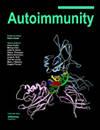SAA1作为胶质母细胞瘤免疫浸润相关预后生物标志物的鉴定
IF 3.3
4区 医学
Q3 IMMUNOLOGY
引用次数: 0
摘要
摘要胶质母细胞瘤(GBM)是中枢神经系统(CNS)中最致命的肿瘤,由于治疗耐受性和肿瘤复发,GBM预后较差;需要新的分子生物标志物来获得准确的预后并促进治疗策略。对来自基因表达综合征(GEO)的数据进行分析以筛选差异表达基因(DEGs),并筛选出279个DEGs。构建并可视化了DEG的蛋白质-蛋白质相互作用(PPI)网络,从而使用Cytoscape鉴定了前10个枢纽基因。通过富集分析探讨了DEGs的功能,DEGs在肿瘤相关的生物学过程和途径中富集。基因表达谱交互分析(GEPIA)数据库用于鉴定预后基因;血清淀粉样蛋白A1(SAA1)被确定为一个重要的预后基因,因为SAA1的高表达与低总生存率(OS)相关(HR=1.5,p < .05)和较差的无病生存率(DFS)(HR=1.9 < .01)。来自中国胶质瘤基因组图谱数据库的数据集验证了SAA1的预后价值,并报告了SAA1表达与临床特征之间的关系,包括年龄、性别、复发史和IDH状况。基因集富集分析(GSEA)确定了6个SAA1相关途径;通路的识别可以为GBM的治疗策略提供见解。最后,探讨了SAA1表达与免疫浸润的关系,结果表明,SAA1的表达与T细胞的浸润水平呈负相关,SAA1与Treg细胞的浸润程度呈正相关。SAA1的过表达与GBM的OS和DFS较差有关,SAA1基因的表达可能影响免疫细胞的浸润水平。因此,SAA1可能是一种有前景的与免疫浸润相关的预后生物标志物和GBM的治疗靶点。本文章由计算机程序翻译,如有差异,请以英文原文为准。
Identification of SAA1 as a prognostic biomarker associated with immune infiltration in glioblastoma
Abstract Glioblastoma (GBM) is the most lethal tumour in the central nervous system (CNS), GBM has a poor prognosis due to treatment tolerance and tumour recurrence; new molecular biomarkers are needed to acquire accurate prognosis and to promote therapeutic strategies. Data from Gene Expression Omnibus (GEO) was analysed to screen differentially expressed genes (DEGs), and 279 DEGs were screened. The protein–protein interaction (PPI) network of DEGs was constructed and visualized, top 10 hub genes were identified by using Cytoscape consequently. The function of DEGs was explored by enrichment analysis, DEGs were enriched in tumour-associated biologic processions and pathways. Gene Expression Profiling Interactive Analysis (GEPIA) database was used to identify prognostic genes; serum amyloid A1 (SAA1) was identified as a critical prognostic gene due to higher SAA1 expression associated with poor overall survival (OS) (HR = 1.5, p < .05) and poor disease-free survival (DFS) (HR = 1.9, p < .01). Dataset from The Chinese Glioma Genome Atlas database validated the prognostic value of SAA1 and reported the relationship between SAA1 expression and clinical characteristics, including age, sex, history of relapse, and the status of IDH. Gene set enrichment analysis (GSEA) identified six SAA1-related pathways; the identification of pathways could provide insight into the therapeutic strategies of GBM. Lastly, the relationship between SAA1 expression and immune infiltration was explored, and the result showed that SAA1 expression negatively correlated with the infiltration level of T cells, and SAA1 expression positively correlated with the infiltration level of Treg cells. The overexpression of SAA1 was associated with poor OS and DFS in GBM, and the expression of the SAA1 gene may affect the infiltration level of immune cells. Therefore, SAA1 could be a promising prognostic biomarker associated with immune infiltration and therapeutic target for GBM.
求助全文
通过发布文献求助,成功后即可免费获取论文全文。
去求助
来源期刊

Autoimmunity
医学-免疫学
CiteScore
5.70
自引率
8.60%
发文量
59
审稿时长
6-12 weeks
期刊介绍:
Autoimmunity is an international, peer reviewed journal that publishes articles on cell and molecular immunology, immunogenetics, molecular biology and autoimmunity. Current understanding of immunity and autoimmunity is being furthered by the progress in new molecular sciences that has recently been little short of spectacular. In addition to the basic elements and mechanisms of the immune system, Autoimmunity is interested in the cellular and molecular processes associated with systemic lupus erythematosus, rheumatoid arthritis, Sjogren syndrome, type I diabetes, multiple sclerosis and other systemic and organ-specific autoimmune disorders. The journal reflects the immunology areas where scientific progress is most rapid. It is a valuable tool to basic and translational researchers in cell biology, genetics and molecular biology of immunity and autoimmunity.
 求助内容:
求助内容: 应助结果提醒方式:
应助结果提醒方式:


